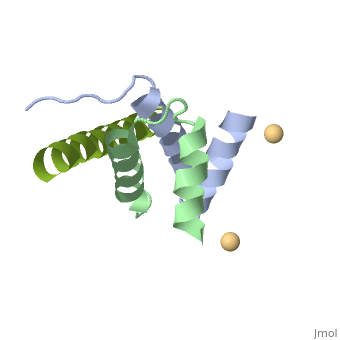4zp3
From Proteopedia
(Difference between revisions)
| Line 1: | Line 1: | ||
==AKAP18:PKA-RIIalpha structure reveals crucial anchor points for recognition of regulatory subunits of PKA== | ==AKAP18:PKA-RIIalpha structure reveals crucial anchor points for recognition of regulatory subunits of PKA== | ||
| - | <StructureSection load='4zp3' size='340' side='right' caption='[[4zp3]], [[Resolution|resolution]] 2.63Å' scene=''> | + | <StructureSection load='4zp3' size='340' side='right'caption='[[4zp3]], [[Resolution|resolution]] 2.63Å' scene=''> |
== Structural highlights == | == Structural highlights == | ||
| - | <table><tr><td colspan='2'>[[4zp3]] is a 18 chain structure. Full crystallographic information is available from [http://oca.weizmann.ac.il/oca-bin/ocashort?id=4ZP3 OCA]. For a <b>guided tour on the structure components</b> use [http://oca.weizmann.ac.il/oca-docs/fgij/fg.htm?mol=4ZP3 FirstGlance]. <br> | + | <table><tr><td colspan='2'>[[4zp3]] is a 18 chain structure with sequence from [http://en.wikipedia.org/wiki/Human Human]. Full crystallographic information is available from [http://oca.weizmann.ac.il/oca-bin/ocashort?id=4ZP3 OCA]. For a <b>guided tour on the structure components</b> use [http://oca.weizmann.ac.il/oca-docs/fgij/fg.htm?mol=4ZP3 FirstGlance]. <br> |
</td></tr><tr id='ligand'><td class="sblockLbl"><b>[[Ligand|Ligands:]]</b></td><td class="sblockDat"><scene name='pdbligand=CD:CADMIUM+ION'>CD</scene></td></tr> | </td></tr><tr id='ligand'><td class="sblockLbl"><b>[[Ligand|Ligands:]]</b></td><td class="sblockDat"><scene name='pdbligand=CD:CADMIUM+ION'>CD</scene></td></tr> | ||
| + | <tr id='gene'><td class="sblockLbl"><b>[[Gene|Gene:]]</b></td><td class="sblockDat">PRKAR2A, PKR2, PRKAR2 ([http://www.ncbi.nlm.nih.gov/Taxonomy/Browser/wwwtax.cgi?mode=Info&srchmode=5&id=9606 HUMAN]), AKAP7, AKAP15, AKAP18 ([http://www.ncbi.nlm.nih.gov/Taxonomy/Browser/wwwtax.cgi?mode=Info&srchmode=5&id=9606 HUMAN])</td></tr> | ||
<tr id='resources'><td class="sblockLbl"><b>Resources:</b></td><td class="sblockDat"><span class='plainlinks'>[http://oca.weizmann.ac.il/oca-docs/fgij/fg.htm?mol=4zp3 FirstGlance], [http://oca.weizmann.ac.il/oca-bin/ocaids?id=4zp3 OCA], [http://pdbe.org/4zp3 PDBe], [http://www.rcsb.org/pdb/explore.do?structureId=4zp3 RCSB], [http://www.ebi.ac.uk/pdbsum/4zp3 PDBsum], [http://prosat.h-its.org/prosat/prosatexe?pdbcode=4zp3 ProSAT]</span></td></tr> | <tr id='resources'><td class="sblockLbl"><b>Resources:</b></td><td class="sblockDat"><span class='plainlinks'>[http://oca.weizmann.ac.il/oca-docs/fgij/fg.htm?mol=4zp3 FirstGlance], [http://oca.weizmann.ac.il/oca-bin/ocaids?id=4zp3 OCA], [http://pdbe.org/4zp3 PDBe], [http://www.rcsb.org/pdb/explore.do?structureId=4zp3 RCSB], [http://www.ebi.ac.uk/pdbsum/4zp3 PDBsum], [http://prosat.h-its.org/prosat/prosatexe?pdbcode=4zp3 ProSAT]</span></td></tr> | ||
</table> | </table> | ||
| Line 18: | Line 19: | ||
</div> | </div> | ||
<div class="pdbe-citations 4zp3" style="background-color:#fffaf0;"></div> | <div class="pdbe-citations 4zp3" style="background-color:#fffaf0;"></div> | ||
| + | |||
| + | ==See Also== | ||
| + | *[[A-kinase anchor protein|A-kinase anchor protein]] | ||
| + | *[[A-kinase anchor protein 3D structures|A-kinase anchor protein 3D structures]] | ||
| + | *[[CAMP-dependent protein kinase 3D structures|CAMP-dependent protein kinase 3D structures]] | ||
== References == | == References == | ||
<references/> | <references/> | ||
__TOC__ | __TOC__ | ||
</StructureSection> | </StructureSection> | ||
| + | [[Category: Human]] | ||
| + | [[Category: Large Structures]] | ||
[[Category: Autenrieth, K]] | [[Category: Autenrieth, K]] | ||
[[Category: Daumke, O]] | [[Category: Daumke, O]] | ||
Revision as of 08:45, 26 June 2019
AKAP18:PKA-RIIalpha structure reveals crucial anchor points for recognition of regulatory subunits of PKA
| |||||||||||
Categories: Human | Large Structures | Autenrieth, K | Daumke, O | Faelber, K | Goetz, F | Heinemann, U | Herberg, F W | Klussmann, E | Krause, G | Kreuchwig, A | Roske, Y | Zuehlke, K | Akap | Amphiphathic helix | Anchor point | Dd-domain | Signaling protein

